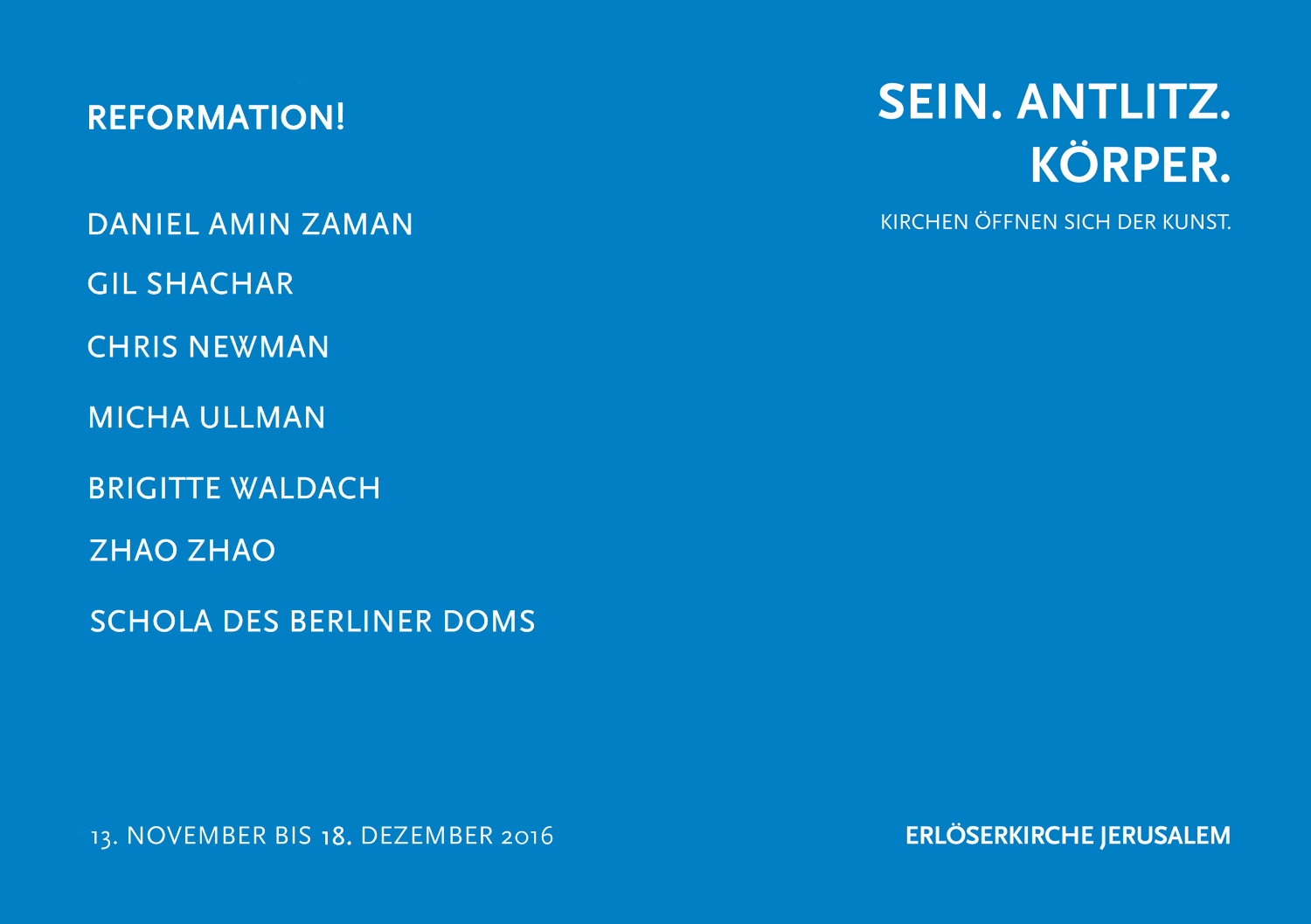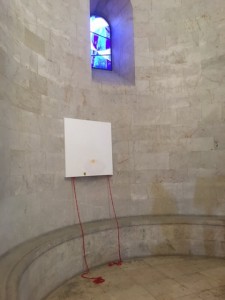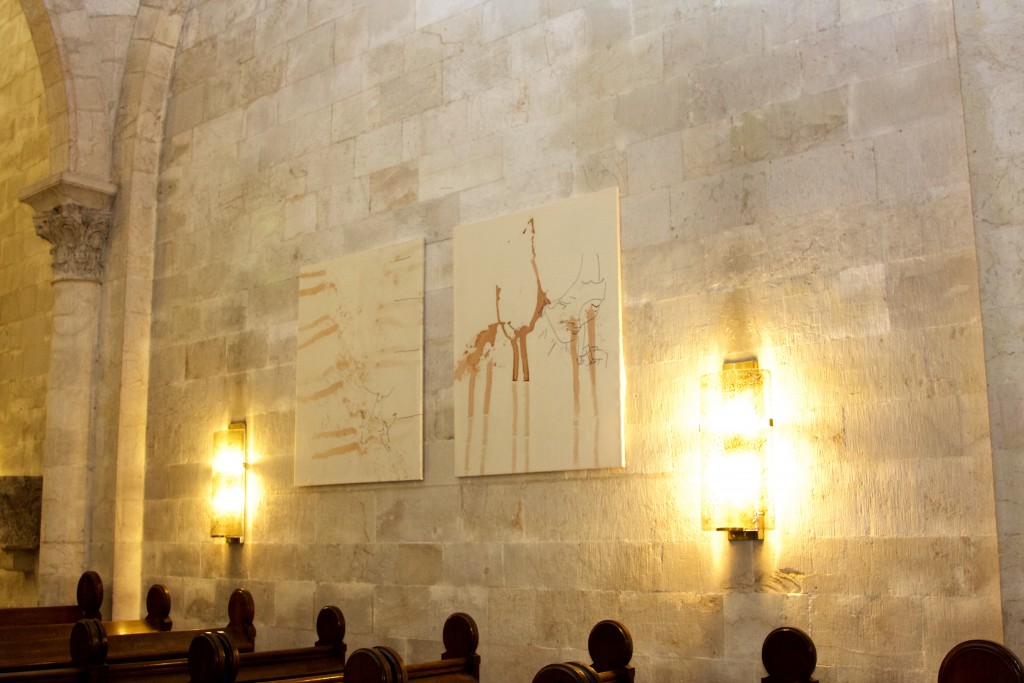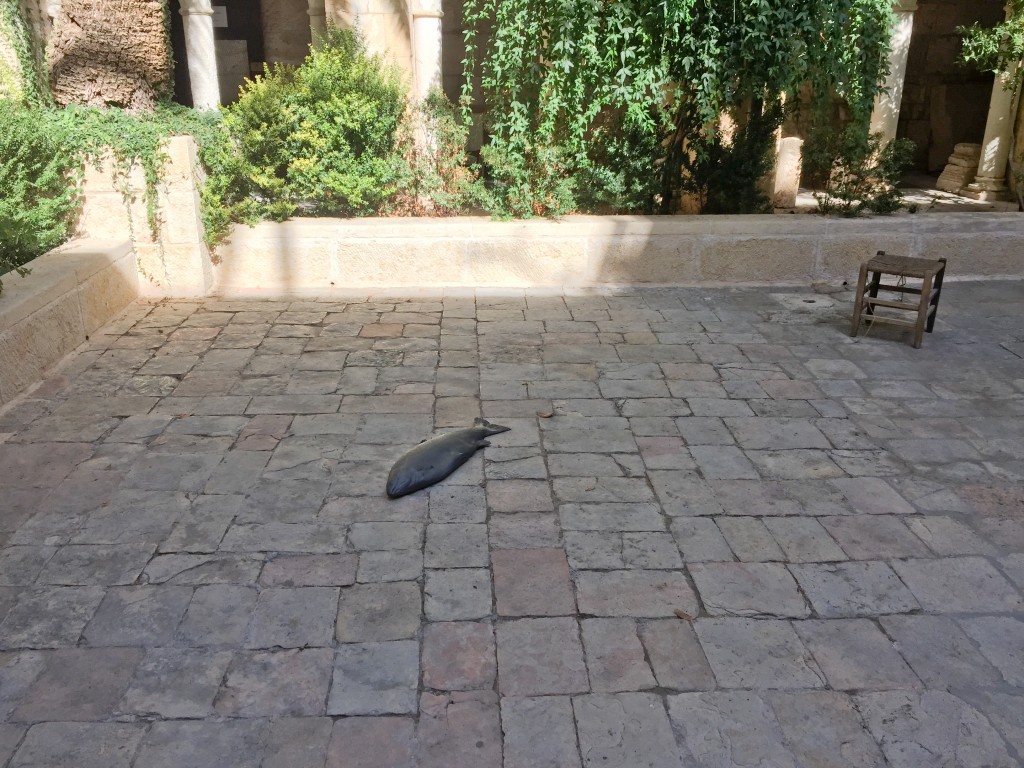
Erlöserkirche Jerusalem
Muristan Road
91140 Jerusalem
Chris Newman, BEHAVIOUR
Uraufführung
10. November 2016
Schola der Kantorei des Berliner Doms; Leitung Tobias Brommann
REFORMATION!
13. November bis 18. Dezember 2016
Öffnungszeiten: Mo – Sa, 10.00 – 17.00 Uhr, Eintritt frei
Mit Werken von Chris Newman, Gil Shachar, Micha Ullman, Brigitte Waldach, Daniel Amin Zaman und Zhao Zhao
Predigt von Propst Schmidt im Eröffnungsgottesdienst
REFORMATION! ist der Titel dieser Ausstellung, an der sich sechs Künstlerinnen und Künstler aus Israel, China, Großbritannien, Deutschland und Österreich mit ihren Werken beteiligen.
Ein wesentliches Element der Reformation war die Einführung des ‚Laienkelchs‘, also die Praxis, beim Abendmahl neben dem Brot auch den Wein zu sich zu nehmen. In der alten Kirche war die Spendung der Kommunion unter beiderlei Gestalten von Brot und Wein üblich. Dies galt vor allem auch zu Zeiten der Verfolgung. Die Synode von Oxford spricht noch 1287 vom Laienkelch als gängige Praxis, erst Ende des 13. Jahrhunderts vollzieht sich in der Westkirche ein Wandel und der Wein wird (mit wenigen Ausnahmen) nicht mehr dargereicht. Die Protestanten holen sich den Weinkelch zurück, Kaiser Karl V. lässt ihn 1528 zu.

Micha Ullma, Vulkan, 2012, Courtesy Artist, Foto Alexander Ochs
Brot und Wein, Salz und Fisch stehen als Momente christlicher Ikonographie im Mittelpunkt der Ausstellung, die sich zugleich mit der jüdischen Praxis des Gebots, Gott nicht abzubilden, auseinandersetzt. Dies meint, die Ausstellung verzichtet auf Gottesdarstellungen, wie sie mit Ausnahme der weitestgehend ‚leeren Gesichter‘ der Künstlerin Brigitte Waldach auch auf menschliche Darstellungen, also das körperliche Abbild eines imaginierten Gottes, verzichtet.
Der in Berlin lebende britische Künstler und Komponist Chris Newman malte 1990 Bilder, für die er Rotwein als Farbe verwendete. Der Farbauftrag dieser teilweise abstrakten Gemälde lässt an Blut und Stigmata denken.
Der 1982 in der uigurischen Provinz Xinjiang geborene chinesische Künstler Zhao Zhao war 2012 mit einem Ausstellungsverbot belegt. Er malte in Reaktion darauf kleinformatige Bilder von Broten, die in seiner islamisch geprägten Heimatprovinz als Feiertagsspezialität gebacken werden. Zhao Zhao setzt seine Brote in Räume vor schwarzem Grund und feinen weißen Linien, die an die Fenster von Gefängniszellen erinnern.

Daniel Amin Zaman, cephalopoda, 2015, Courtesy Artist, Foto Alexander Ochs
Micha Ullman, 1939 als Sohn eines Thüringer Migranten in Tel Aviv geboren, verwendet Salz aus seines Vaters Heimat um eine kreisförmige Bodenskulptur zu schaffen, in deren Zentrum sich ein gläsernes Trinkgefäß befindet. Ullman, einer der wichtigsten israelischen Bildhauer, widmete diese Skulptur ursprünglich seiner vor dem Hitlerfaschismus geflüchteten Tante.
Der in Wien lebende Sohn eines indisch-sunnitischen Migranten, Daniel Amin Zaman, steuert drei skulpturale Arbeiten bei. Sie lehnen sich an einen Text mit dem Titel ‚Cloths of Heaven‘ von William Butler Yeats, einem im 19. Jahrhundert geborenen Iren, an. Im Zentrum der künstlerischen Arbeit wird die Frage nach menschlicher Identität zwischen Himmel und Erde gestellt.
Wein und Brot, Himmel und Erde – der in Deutschland lebende israelische Künstler Gil Shachar formt die Skulptur eines Fisches, Brigitte Waldach fertigt zehn Zeichnungen zum Dekalog. Waldach zeigt zehn Figuren, die sie einerseits mit den Texten der zehn Gebote und andererseits mit eigenen, stark kontemplativen Zeilen versieht.
Chris Newman tritt auch als Komponist auf und hat der Schola des Berliner Doms unter Leitung des Domkantors Tobias Brommann eine Komposition mit dem Titel Behaviour gewidmet, die in Jerusalem zur Uraufführung kommt.

Ausstellungsansicht Erlöserkirche Jerusalem, Chris Newman, 13-020 und 13-021, 2009 Courtesy Artist, Foto Hans Walter
English version
REFORMATION! is the title of this exhibition, which features the work of six artists from Israel, China, the UK, Germany and Austria.
A significant element of the Reformation was the introduction of the practice of offering the chalice to the laity, that is to say, the practice of partaking not only of bread at Communion, but also wine. In the Old Church, Communion was usually given using both bread and wine. This applied especially in times of persecution. Even in 1287, the Synod of Oxford spoke of the Communion cup for laity being usual practice. It was only at the end of the 13th century that the western Church underwent a change, and (with a few exceptions), the wine was no longer proffered. The Protestants however brought back the wine chalice. This was permitted by Kaiser Karl V in 1528.
Bread and wine, salt and fish are a central focus of the exhibition, where they stand as elements of Christian iconography. At the same time, the exhibition tackles the Jewish practice of not depicting God. This means that the exhibition does away with depictions of God (with the exception of artist Brigitte Waldach’s largely ‘empty faces’), just as it also dispenses with human portrayals, ie the bodily image of an imagined God.
In 1990, the Berlin-based British artist and composer Chris Newman painted pictures using red wine as paint. The application of the paint on these partly abstract paintings is reminiscent of blood and stigmata.
The Chinese artist Zhao Zhao, born in 1982 in the Uyghur province Xinjiang was forbidden from exhibiting in 2012. In reaction to this, he painted small-format pictures of the breads that, in his predominantly Islamic home province, are baked as feast day specialities. Zhao Zhao sets his breads in scene against a black background and with thin white lines that are reminiscent of the windows of prison cells.
Micha Ullmann, born in 1939 in Tel Aviv as the son of an immigrant from the German state of Thuringia, uses salt from his father’s homeland to create a circular floor sculpture in whose centre a glassy drinking vessel can be found. Ullmann, one of the most important Israeli sculptors, originally dedicated this work to his aunt, who fled the Nazis.

Ausstellungsansicht Erlöserkirche Jerusalem, Gil Shachar, Fisch, 2016, Courtesy Artist, Foto Alf Setzer
Daniel Amin Zaman, the son of an Indian Sunni immigrant, and who lives in Vienna, contributes three sculptural works. They are based on the text ‘Cloths of Heaven’, by WB Yeats, born in Ireland in the 19th century. In the centre of the artistic work, the question of human identity between Heaven and Earth is posed.
Wine and bread, Heaven and Earth – The Germany-based Israeli artist Gil Schachar shapes the sculpture of a fish, and Brigitte Waldach has produced ten drawings on the Decalogue. Waldach shows ten figures, which she furnishes not only with the text of the Ten Commandments, but also with her own, deeply contemplative texts.
Chris Newman also appears as a composer, and has bestowed upon the Schola of Berlin Cathedral, under the direction of cathedral cantor Tobias Brommann, a composition with the title Behaviour, which will be premiered in Jerusalem.